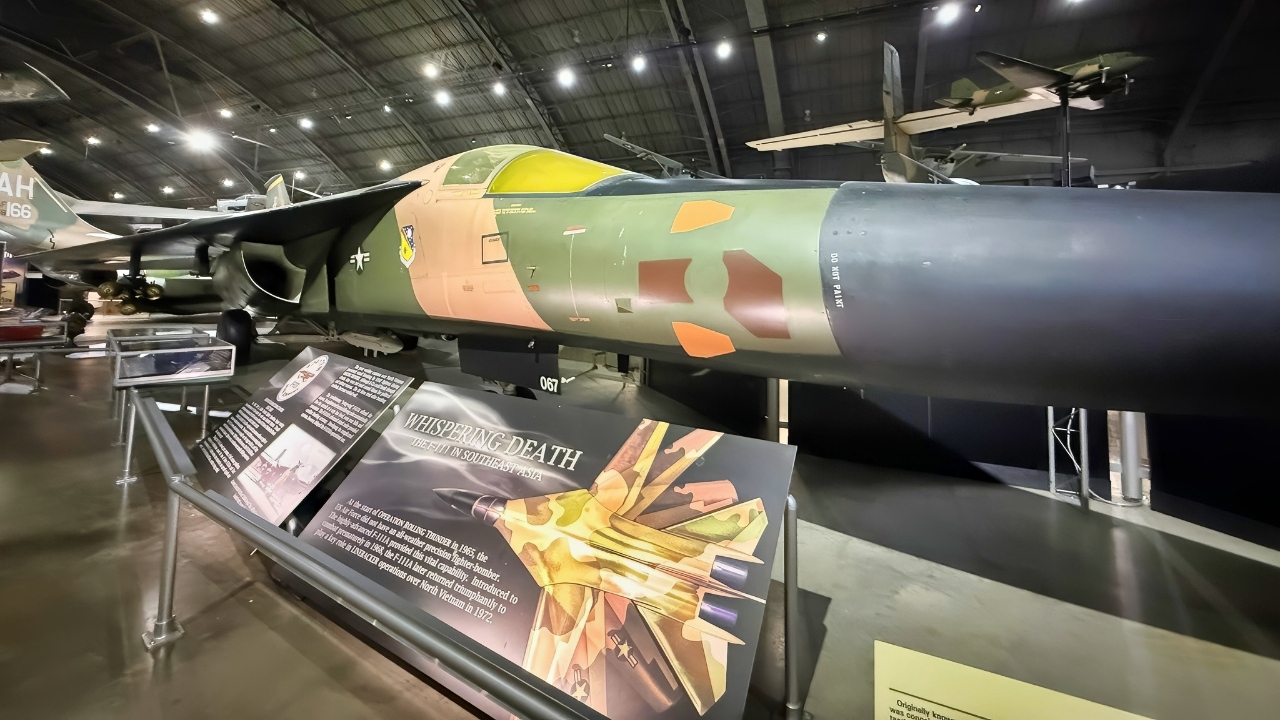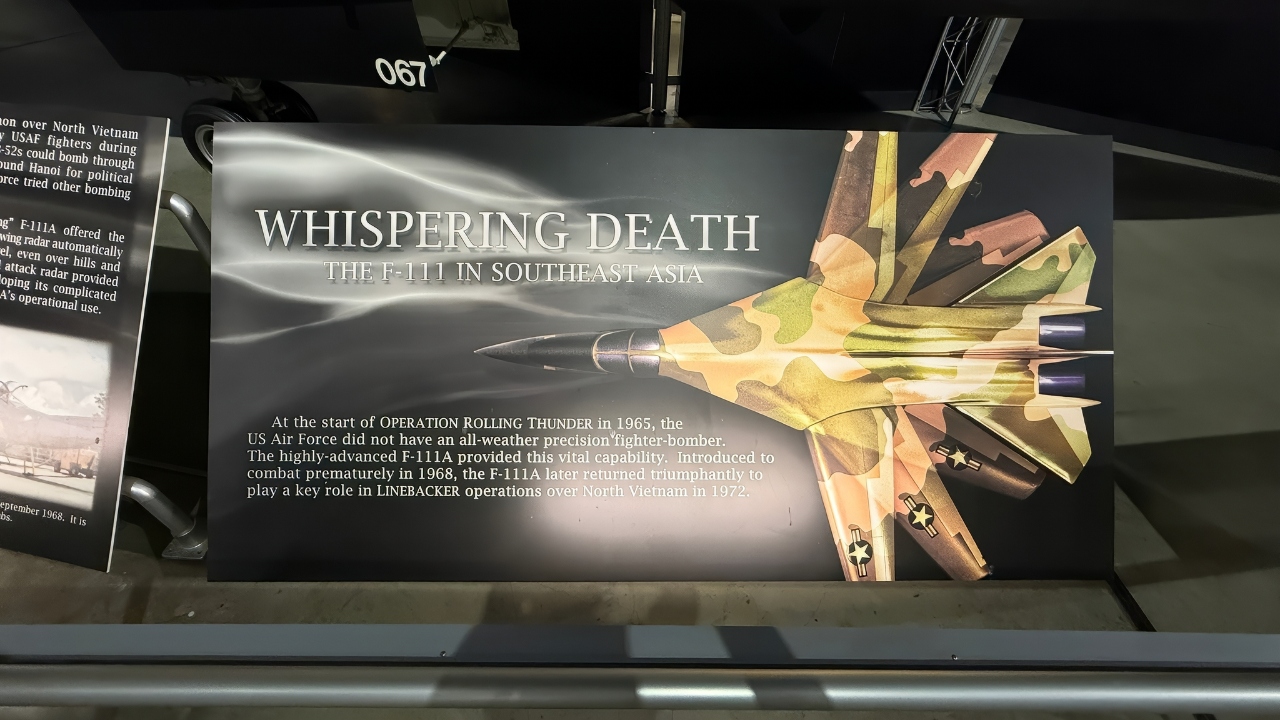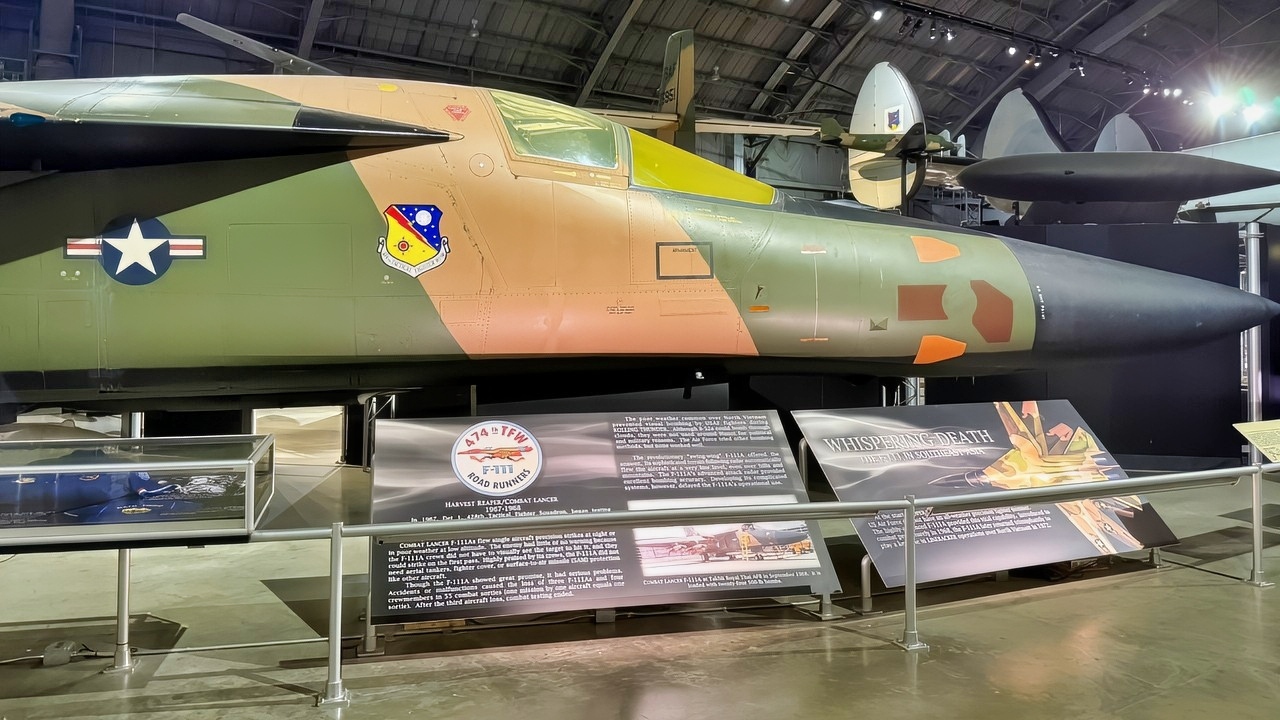Key Points and Summary – The F-111 Aardvark grew from the 1960s TFX drive to field a fast, long-range strike jet.
-General Dynamics’ swing-wing design, twin TF30 turbofans and the first production terrain-following radar let it skim low at Mach 2+ carrying up to 31,500 lb of bombs, missiles or nukes.

USAF Museum F-111 National Security Journal New Photo.
-It debuted in Vietnam, matured into the D/E/F variants, spawned the FB-111A bomber and EF-111A Raven jammer, and served with Australia until 2010.
-Costly upkeep and aging systems ended U.S. service by the late 1990s, but its payload, penetration tactics and multi-role DNA shaped aircraft from the F-14 and Tornado to the F-15E.
-Bonus: We included photos from a recent July visit to the U.S. Air Force Museum where a F-111 in currently on display.
Meet the F-111 Aardvark
F-111 Aardvark was a twin-seat supersonic strike fighter developed by General Dynamics for the United States Air Force.
The aircraft featured advanced avionics for its time and a payload capacity far surpassing that of most fighters, even by today’s standards.
It saw numerous combat missions in both Vietnam and the Gulf War and flew for both the American and Australian air forces. At the end of the Cold War, however, the Aircraft was too expensive to maintain, leading to its subsequent retirement.

F-111 Photo from USAF Museum in Dayton. Image Credit: National Security Journal.
Design and Development
Development on the F-111 started back in the 1960s, when the U.S. Department of Defense launched the Tactical Fighter Experimental (TFX) program.
The goal was to create a single aircraft that could meet the needs of both the Air Force and the Navy.
The Air Force wanted a long-range strike aircraft capable of flying at high speeds and low altitudes to penetrate Soviet air defenses, while the Navy sought a fleet defense interceptor with carrier compatibility.
This joint-service approach was unprecedented and ultimately proved too ambitious. General Dynamics won the contract in 1962, and the first prototype flew in 1964.
However, the Navy soon withdrew from the program due to concerns over the aircraft’s size, weight, and performance on aircraft carriers. The Air Force continued development, and the F-111 entered service in 1967.
The F-111 featured a variable sweep-wing configuration that improved its performance at supersonic speeds. These “swing wings” could be extended for takeoff, landing, and low-speed flight, and swept back for high-speed performance.

F-111 In USAF Museum July 2025 NSJ Image Taken by Harry J. Kazianis.
This gave the aircraft exceptional versatility, allowing it to operate effectively across a wide range of mission profiles.
The F-111 was also the first production aircraft to feature terrain-following radar, which enabled it to fly automatically at low altitudes by following the contours of the terrain.
This capability was crucial for evading radar detection and surface-to-air missiles during deep penetration missions into hostile territory.
One of the Fastest Strike Fighters to take to the Skies
The aircraft was powered by two Pratt & Whitney TF30-P-100 afterburning turbofan engines, which allowed it to reach speeds exceeding Mach 2.5. These engines were powerful but also contributed to early reliability issues, particularly in the Navy’s canceled F-111B variant. Another innovative feature was the crew escape module.
Instead of traditional ejection seats, the F-111 used a capsule-style escape system. In an emergency, the entire cockpit module would eject, protecting the crew from high-speed windblast and allowing for safer recovery.
The aircraft also featured an internal weapons bay and external hardpoints, enabling it to carry a wide variety of ordnance, including nuclear weapons, conventional bombs, and air-to-ground missiles.

F-111. Image Credit: Creative Commons.
The F-111 Aardvark had an impressive payload capacity for its time, capable of carrying up to 31,500 pounds (14,300 kilograms) of ordnance.
This included a mix of conventional and nuclear weapons, housed both internally and on external hardpoints.
Its internal weapons bay could accommodate precision-guided munitions, fuel tanks, or reconnaissance gear, while its external pylons supported bombs, missiles, and electronic warfare pods. This heavy payload, combined with its long range and high-speed penetration capabilities, made the F-111 a formidable strike aircraft in both tactical and strategic roles.
Over the years, several variants of the F-111 were developed to fulfill different roles. The F-111A was the initial production model for the Air Force.
The F-111B was the Navy’s version, which was ultimately canceled. The F-111C was an export version for the Royal Australian Air Force. Improved models such as the F-111D, E, and F featured upgraded avionics, engines, and payload capacity. The EF-111A Raven was an electronic warfare variant equipped with jamming equipment, while the FB-111A was a strategic bomber variant used by the Strategic Air Command.
Combat History and Retirement
The F-111 saw its combat debut during the Vietnam War, where it conducted deep strike missions against heavily defended targets. Early losses due to mechanical failures led to skepticism, but later missions demonstrated its effectiveness.
Its ability to fly low and fast made it ideal for penetrating enemy defenses. During the Cold War, the FB-111A variant played a key role in the USAF’s strategic doctrine. It was part of the nuclear triad and capable of delivering nuclear weapons deep into Soviet territory. Its speed and low-level penetration capabilities made it a formidable deterrent.
Australia was the only foreign operator of the F-111, acquiring the F-111C variant in the early 1970s. The aircraft served the Royal Australian Air Force until 2010, providing long-range strike capability across the Asia-Pacific region.
The Australian F-111s were upgraded over time and became a cornerstone of the country’s defense strategy. Their retirement marked the end of an era in Australian air power.
The USAF retired the F-111 in the 1990s, with the last EF-111A Raven leaving service in 1998. The RAAF retired its fleet in 2010, replacing it with the F/A-18F Super Hornet. Despite its early problems, the F-111 left a lasting legacy. It proved the viability of variable-geometry wings, influencing aircraft like the F-14 Tomcat and Panavia Tornado. Its terrain-following radar and low-level penetration tactics became standard in strike aircraft doctrine.
The modular escape capsule concept, while not widely adopted, demonstrated innovative thinking in crew survivability.
The F-111’s multi-role capability foreshadowed the design philosophy behind modern aircraft like the F-15E Strike Eagle and F-35 Lightning II.
About the Author: Isaac Seitz
Isaac Seitz, a Defense Columnist, graduated from Patrick Henry College’s Strategic Intelligence and National Security program. He has also studied Russian at Middlebury Language Schools and has worked as an intelligence Analyst in the private sector.
More Military
Russia’s MiG-29 Fulcrum Fighter Has a Message for NATO
The X-40A Space Plane Has a Message for the U.S. Military
The Mach 6.7 X-15 Space Plane Has a Message for the U.S. Air Force










